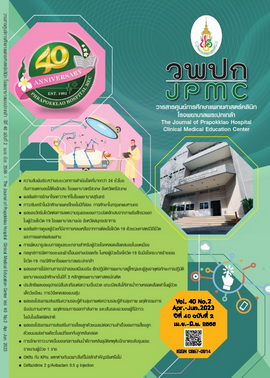Development of an Intermediate Care Model for Stroke Patients in Urban Areas
Main Article Content
Abstract
BACKGROUND: Cerebrovascular disease lead to physical, psychological, social, and economic problems, particularly at the sub-acute stage when a patient’s condition is unstable. An intermediate care model of care is needed to respond problems and care needs as well as prevent or reduce complications and disabilities.
OBJECTIVES: Research and development were conducted with the aim of studying the problems and care needs of stroke patients at the sub-acute phase, as well as develop an intermediate care model for stroke patients in urban areas and evaluate the suitability of care activities according to the intermediate care model for stroke patients in urban areas.
METHODS: The samples were assessed using 3 steps of a research process. Step 1 involved studying the problems and needs of care for sub-acute stroke patients based on a review of 20 research papers by scoping review. Step 2 concerned developing an intermediate care model for stroke patients in urban areas. The samples comprised a total of 30 people including public health personnel responsible for the care of stroke patients, as well as community leaders, village health volunteers, stroke patients, and caregivers in Khon Kaen Province. Step 3 assessed the suitability of care activities according to the intermediate care model for urban stroke patients. Public health personnel were divided into operational level and executive level with 20 and 15 people, respectively, while a total of 35 people were key informants. All samples were selected through purposive sampling. The research tools comprised a brainstorming approach and a questionnaire to assess the appropriateness of activities based on the intermediate care model for stroke patients in urban areas.
RESULTS: The results showed that the problems of stroke patients at the sub-acute stage included mobility, thoughts and memory problems, swallowing, stress, depression, suicidal thoughts, and loss of identity. Being isolated from society, having no income, and lacking the right to medical care that requires physical, mental, social, and economic care were also found to be issues. The intermediate care model for stroke patients in urban areas consisted of referrals for cerebrovascular disease, patient classification, defining the roles and duties of multidisciplinary teams, home care, assessing problems and providing physical, mental, social, and economic care as well as assessing results according to quality indicators and health personnel, which evaluated activities according to the patterns at the highest level of all activities.
CONCLUSIONS: The developed intermediate care model for stroke patients was appropriate for the urban context. It was found that the appropriateness of all activities according to the pattern was at the highest level and could be developed in terms of care for cerebrovascular disease in transitional care from hospital to home.
Article Details

This work is licensed under a Creative Commons Attribution-NonCommercial-NoDerivatives 4.0 International License.
References
World stroke organization.Annual Report 2019. [Internet].2019 [cited 2021 March 20]. Available from: https://www.world-stroke.org/assets/downloads/WSO_2019_Annual_Report_online.pdf
Muengtaweepongsa S. Cerebrovascular and critical care neurology. 3rd ed. Bangkok: Thammasatuniversity Press; 2022.
Chinchai P. Health Promotion and Rehabilitation for Hemiplegia. Chiang Mai: Siam Pimnana; 2013.
Gencer AG, Hocaoglu C. Post-stroke neuropsychiatric problems. Psikiyatride Günce lYaklaşımlar-Current Approaches in Psychiatry [Internet]. 2019[cited 2021 Mar 21];11(4):419-37. Available from: https://dergipark.org.tr/tr/download/article-file/784649
Seesawang J, Rungnoei N. Nursing care for stroke patients: strategies towards patient-centered care. J NursSci [Internet]. 2016[cited 2021 Mar 21];34(3):10-8. Available from: https://www.tci-thaijo.org/index.php/ns/article/view/77535/62192.pdf.
Phikul P, DitsuwanV, Buakeaw K. Needs assessment for cerebrovascular disease patients inRassadahospital health services network, Rassadadistrict, Trang province. Journal of Southern Technology [Internet].2019 [cited 2021 Mar 21];12(1):183-92. Available from: https://www.tci-thaijo.org/index.php/journal_sct/article/view/117854/131704. pdf.
SenasanaS, KomjakraphanS, Isaramalai S. Development of the home-based skill training program for caregivers of stroke patients. Journal of Preventive Medicine Association of Thailand [Internet].2017[cited 2021 Mar 21];7(2) 212-2. Available from: https://www.tci-thaijo.org/index.php/JPMAT/article/view/128737/96766. pdf.
HaruethaiKongmaha, VilipornRunkawatt, NattiyaPeansungnern, and PratoomKongmaha, The problems that affect finances of elderly patients undergoing stroke recovery at home. IJPHS [Internet]. 2020[cited 2021 Mar 20];2(1):1-9. Available from: https://www.tci-thaijo.org/index.php/ijphs/article/view/188971/166779. pdf.
Ministry of Public Health.Guideline for Intermediate care.Nonthaburi: administration Health division; 2019.
Pratoomtan D, Nimchuen C, Ditwichairut R, The model development of perceptual & cognitive rehabilitation service for people with brain pathology. J Prapokklao Hosp Clin Med Educat Center [Internet]. 2022 [cited 2021 Mar 21]; 39(4): 484-92. Available from: https://www.tci-thaijo.org/index.php/ppkjournal/article/view/257773/177535.pdf.
Triyawong D, Lacampan S, Rawiworrakul T. Effect of the supportive-educative nursing program on capability of family caregiver for caring post stroke. J Prapokklao Hosp Clin Med Educat Center [Internet] 2020 [cited 2021 Mar 21];37(3): 240-9. Available from: https://www.tci-thaijo.org/index.php/ppkjournal/article/view/240700/165565.pdf.

